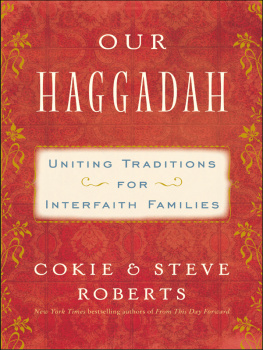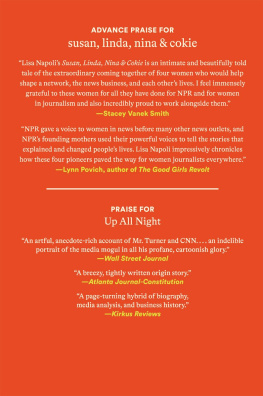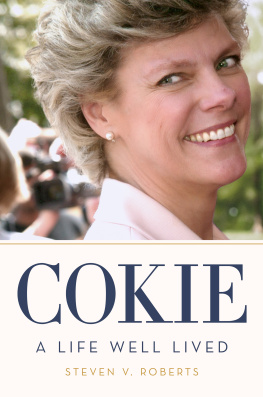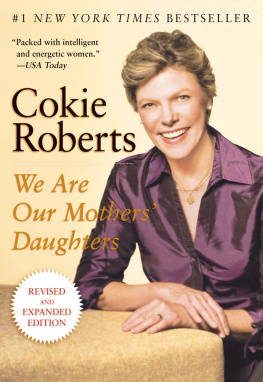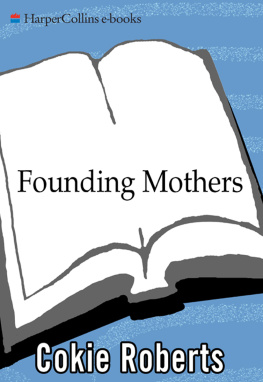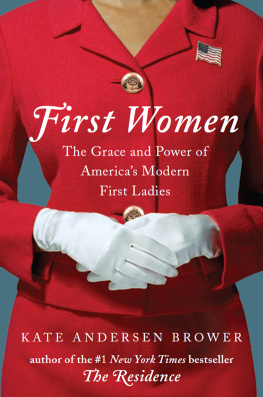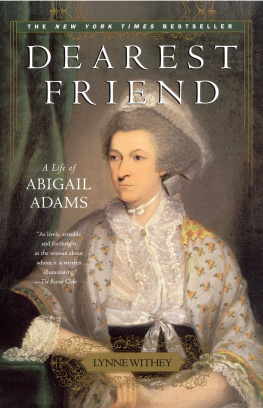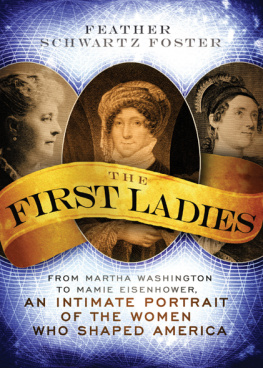F IRST A WORD ABOUT what this book is and what it isnt. It is the story, told as much as possible in their own words, of the influential women in the period between the inauguration of John Adams in 1797 and his son, John Quincy Adams in 1825. It is not the story of everyday women in the late eighteenth and early nineteenth centuries, many of whom had much harder lives than the elite women who had the ears of the Founding Fathers. Because I wanted to focus on the story, not the writings, I have modernized and corrected the spelling and punctuation to make the letters and journals easier to read.
This book turned out to be a much bigger undertaking than I expected for happy reasons. After I wrote Founding Mothers, the librarians and custodians of collections, historical societies, and historic homes saw that their troves of papers would be of use, and they have been steadfast about finding unpublished treasures for this project. For a couple of years now, Ive waited with anticipation for some packet of letters to arrive in the mail, providing fresh insights. Once the packets showed up, they were often tough-goingXeroxed eighteenth century handwriting can be very rough to readbut they were thrilling. Seeing Abigail Adamss handwriting is a treat all unto itself. And then there were the unexpected pleasures. Sitting in the beautiful reading room of the Huntington Library, coming across the invitations from members of the Napoleonic court to Ruth and Joel Barlow was truly exciting. It was all I could do not to let out a whoop that would not have pleased my fellow researchers. There were some disappointments along the way as well. I had hoped to find information about my own family. An ancestor, William Charles Cole Claiborne, the first governor of Louisiana, is a character in this book and I thought someone might have letters from at least one of his three wives, but I couldnt find any female Claiborne papers. That was too bad, but there was so much I did find, and that others found for me, that I was able to get to these wonderful women and enable them to speak to us over the centuries. So there are many people to thank.
Ann Charnley, intrepid researcher and friend, has been working with me on books for more than ten years now (she wont let me say how long weve been friends) and this one was by far the most challenging. Knowing what we know now about the need to locate, preserve and publish womens letters, she is launching a fundraising drive to build the Founding Mothers Digital Archive, a website for womens papers, so that posterity will have access to the other half of history. Annie Downing not only did all of the many, many footnotes in this book, she also keeps the rest of my working life on track, with humor and good sense. Heather Gilbert rode in to save me at the last minute by transcribing the letters of Louisa Catherine and John Quincy Adams. My friend and lawyer Bob Barnett shepherded this project as he does all of my work, with my interest at heart. Without Claire Wachtel, my editor and coconspirator, this book wouldnt exist, nor would any of the earlier onesa huge thanks to her for her guidance in many ways, not to mention the laughs. At William Morrow, Barbara Levine found the womens portraits for the cover and chapter heads; Kim Lewis somehow managed to get this book printed with grace under pressure; Joyce Wong, the production editor, had to work super-fast; the phenomenal DeeDee DeBartlo is the best publicist in the business; and thanks to publisher, Lisa Gallagher. And at the parent, HarperCollins: Claires able-assistant Julia Novitch; the talented and kind Michael Morrison, and the woman much like those in this book, the woman who shaped the publishing world, Jane Friedman.
The Massachusetts Historical Society, which has the most amazing website where John Quincy Adamss Diary is available online, was particularly helpful as I kept asking for more and more information about the fascinating Louisa Catherine Adams. Im happy to say that MHS will be publishing her papers soon. Dennis Fiori, the president of the society has been especially supportive, along with Peter Drummey, Judith Graham, Jeremy Dibbell, Laura Lowell, and Kim Nusco. Also, everyone connected with Louise Livingston was a big help. I started with Bonnie Livingston who sent me to Mary Ann Fish who sent me to Wint Aldrich and Joey Delafield, who reproduced the book about Louise for me. At Historic Hudson Valley Kathleen Eagan Johnson and Catalina Hannan were terrific. Thanks to Olga Tsapina and Kate Henningsen for the Ruth Barlow letters at the Huntington Library. Holly Cowan Shulman has created the Dolley Madison Digital Edition, a remarkable resource. Thanks to her and to Jason Coleman for access to it. Dan Preston at the University of Mary Washington, Jim Wootten at Virginias Capitol Square Preservation Council, and Doris Delk at the Virginia Historical Society, aided with the elusive Elizabeth Kortright Monroe. And Fredricka Teute, on a fellowship this year at Washington College, filled in the blanks on Margaret Bayard Smith. Jane Aldrich at the South Carolina Historical Society did the same for Mary Stead Pinckney, along with Henry Fulmer at the University of South Carolina. And to all the following a big thank-you: Dan Jordan, Susan Stein, Sue Purdue, and Jeff Looney at Monticello and Anna Berkes at the Jefferson Library; Jennifer Kittlaus at Mount Vernon; Barbara Bair and Janice Ruth at the Library of Congress; Ellen Dunlap at the American Antiquarian Society; the Historical Society of Washington, D.C.; the New York Historical Society, which is enjoying a grand revival; the New York Public Library; and the Boston Public Library. The Legacy Reprint Series has made access to old books much more available and affordable by reproducing them in inexpensive formats. And Google, the internet search engine, has made research about ten thousand times easier than it was even four years ago. To sit at home and type in the names of the people inviting Ruth Barlow to tea in early nineteenth century Paris and find out who they are in seconds is a blessing. The American Association for State and Local History is the organization representing the custodians of much of this information. Its New Century Endowment Campaign is well worth supporting.
It would be impossible to even contemplate an enterprise of this magnitude without the care of my friends and family. My great girl bosses at NPR and ABC, Ellen McDonnell and Robin Sproul, were understanding as always. Kim Roellig, who has become a good friend over many years, makes it possible for me to continue to be a human being while off on a project like thisshe does what I should be doing but better. My wonderful daughter-in-law, Liza Roberts, offered support above and beyond the ordinary, taking time out from her own busy writing schedule and the raising of my three adorable grandchildren to edit carefully every word. My delightful daughter Rebecca Roberts also added to her already heavy load as radio host and mother of the other three adorable grandchildren to give the book a read and cheer me on. And theres no way to say enough about my husband, Steven. He has picked up the load of much of my over-booked lifenot just by writing our weekly newspaper column and doing a good many house hold chores, but by sharing the caretaking and concern for our mothers, usually a task left to the women of the family. He is my biggest fan and best friend. He is my love. And finally, my smelly old bassett hound, Rupert, who kept me constant company through the writing process. He is very happy that the alarm is no longer going off at five A.M.


